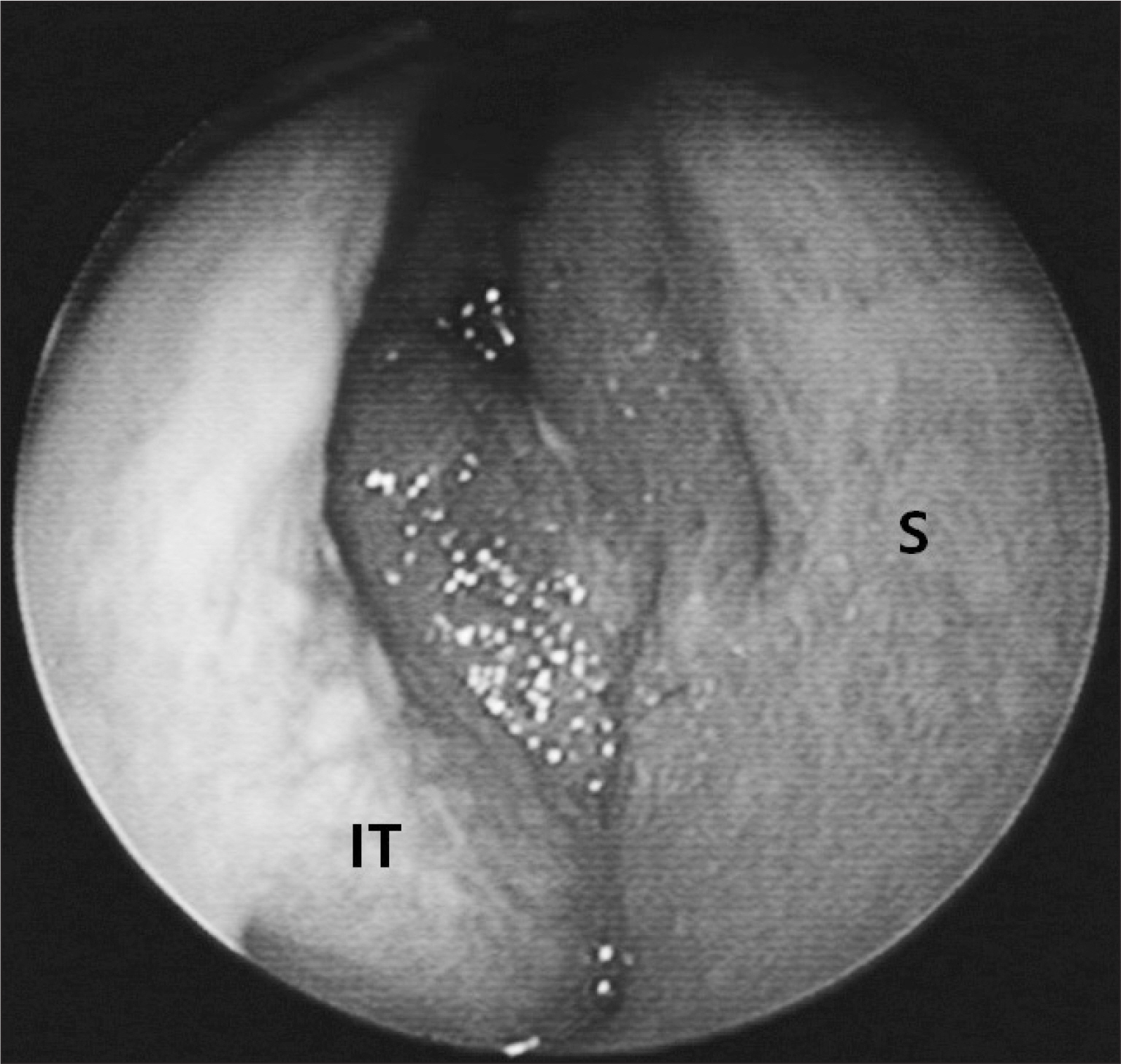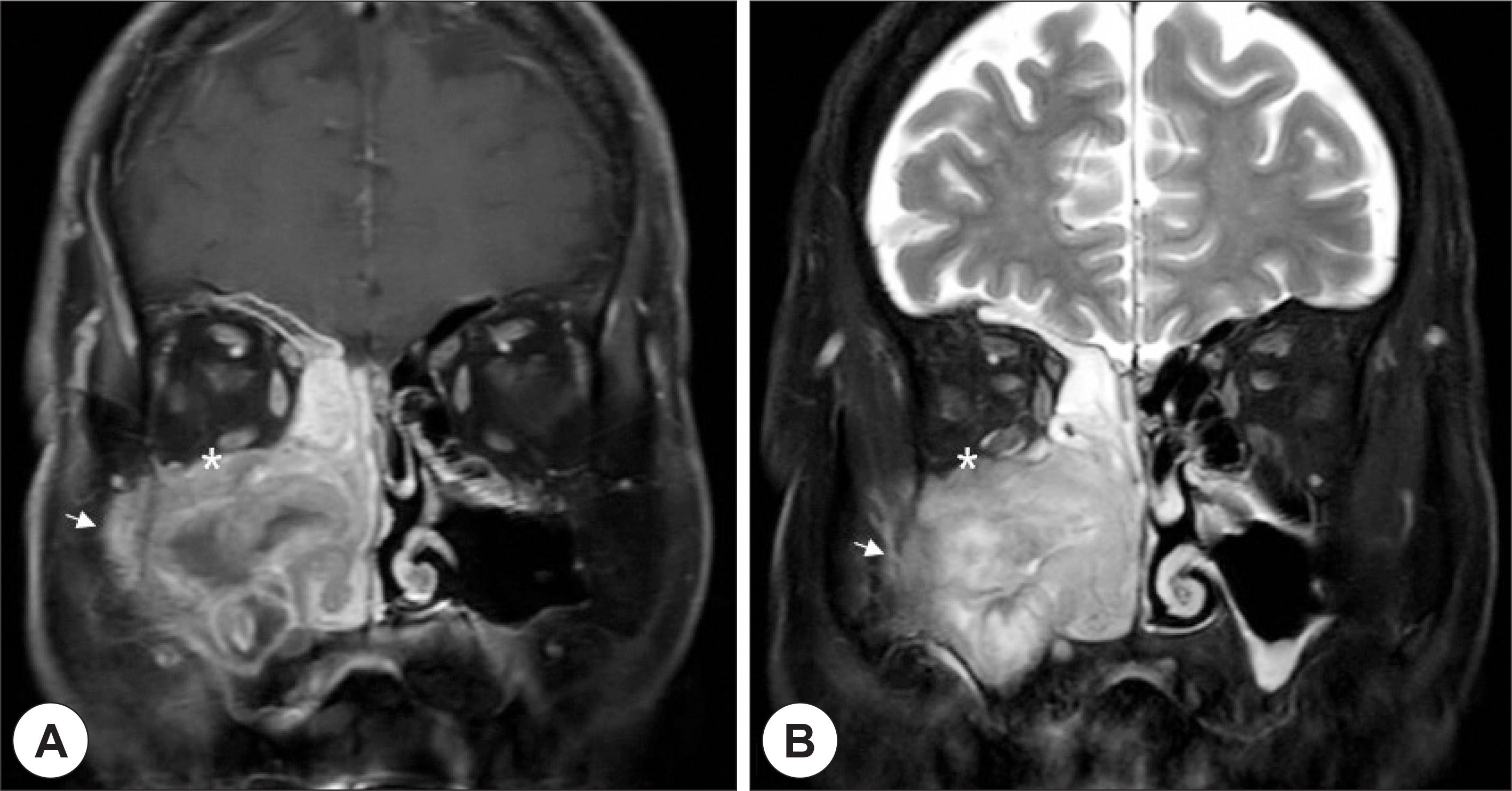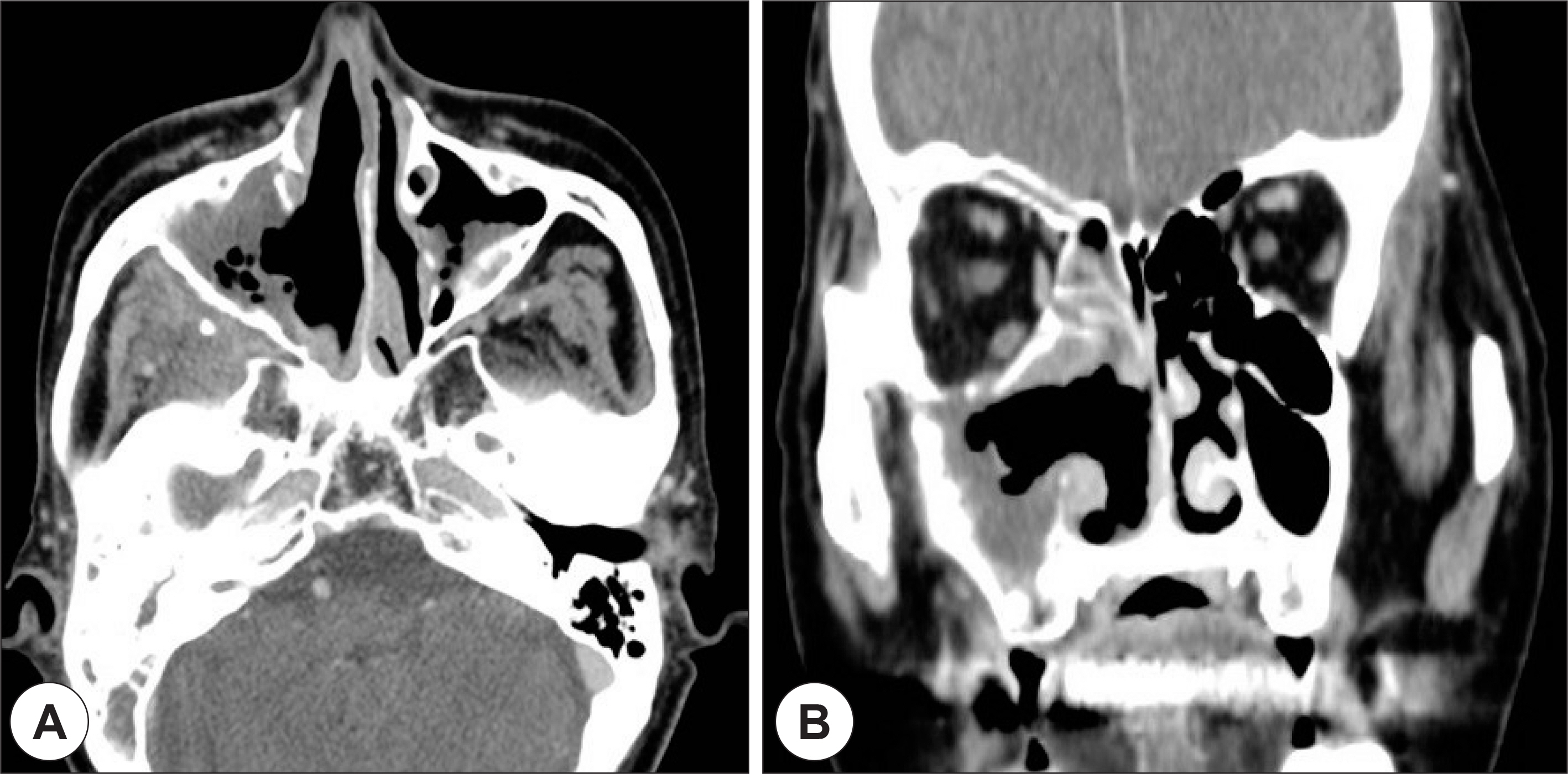J Rhinol.
2016 Nov;23(2):110-114. 10.18787/jr.2016.23.2.110.
A Case of Small Cell Carcinoma of the Maxillary Sinus Coexisting with Fungus Ball
- Affiliations
-
- 1Department of Otolaryngology, Gyeongsang National University, Jinju, Korea. syjeon@gnu.ac.kr
- 2Institute of Health Sciences, Gyeongsang National University, Jinju, Korea.
- KMID: 2361324
- DOI: http://doi.org/10.18787/jr.2016.23.2.110
Abstract
- Small cell carcinoma commonly originates in the lung, with only about 4% of cases arising at extrapulmonary sites. Furthermore, small cell carcinoma of the sinonasal tract is extremely rare. In Korea, only 2 cases of primary sinonasal small cell carcinoma have been reported in the nasal cavity and the nasal septum, respectively. Recently, we have experienced a rare case of small cell carcinoma arising from the right maxillary sinus coexisting with a fungal ball lesion. Herein, we report this case with a review of the literature.
MeSH Terms
Figure
Cited by 1 articles
-
Incidental Finding of Squamous Cell Carcinoma Accompanying a Fungal Ball in the Maxillary Sinus
Hyun Ju Lee, Jung Soo Kim, Sung Jae Heo
Korean J Otorhinolaryngol-Head Neck Surg. 2020;63(4):172-175. doi: 10.3342/kjorl-hns.2019.00108.
Reference
-
References
1). Kang JM, Lee HY, Lee KS, Ko SY. Small cell Neuroendocrine Carcinoma of the Nasal cavity. Korean J Otolaryngol. 2003; 46:164–7.2). Kim YS, Bae CH, Song SY, Kim YD. A case of a small cell neuroendocrine carcinoma of the nasal septum. Korean J Otorhinolaryn-gol-Head Neck Surg. 2009; 52(6):529–32.
Article3). Park CH, Roh JL, Park YH, Rha KS. A Case of Primary Small Cell Carcinoma of the Larynx. Korean J Otolaryngol. 2005; 48:124–6.4). Tang IP, Singh S, Krishnan G, Looi LM. Small cell neuroendocrine carcinoma of the nasal cavity and paranasal sinuses: a rare case. J Laryngol Otol. 2012; 126(12):1284–6.
Article5). Tsukahara K, Nakamura K, Motohashi R, Sato H. Two Cases of Small Cell Cancer of the Maxillary Sunus Treated with Cisplatin plus Irinotecan and Radiotherapy. Case Rep Otolaryngol. 2013; 2013:893638.6). Zhu Q, Zhu W, Wu J, Zhang H. The CT and MRI observations of small cell neuroendocrine carcinoma in paranasal sinuses. World J Surg Oncol. 2015; 13:54.
Article7). Babin E, Rouleau V, Vedrine PO, Toussaint B, de Raucourt D, Ma-lard O, et al. Small cell neuroendocrine carcinoma of the nasal cavity and paranasal sinuses. J Laryngol Otol. 2006; 120(4):289–97.
Article8). Travis WD, Brambilla E, Nicholson AG, Yatabe Y, Austin JHM, Beasley MB, et al. The 2015 WHO classification of lung tumors. J Thorac Oncol. 2015; 10:1243–60.9). Terada T. Primary small cell carcinoma of the maxillary sinus: a case report with immunohistochemical and molecular genetic study involving KIT and PDGFRA. Int J Clin Exp Pathol. 2012; 5(3):264–9.10). Han G, Wang Z, Guo X, Wang M, Wu H, Liu D. Extrapulmonary small cell neuroendocrine carcinoma of the paranasal sinuses: a case report and review of the literature. J Oral Maxillofac Surg. 2012; 70(10):2347–51.
Article11). Kim KO, Lee HY, Chun SH, Shin SJ, Lim MK, Lee KY, et al. Clinical Overview of Extrapulmonary Small cell carcinoma. J Korean Med Sci. 2006; 21:833–7.
Article12). Segawa Y, Nakashima T, Shiratsuchi H, Tanaka R, Mitsugi K, et al. Small Cell Carcinoma of the Tonsil Treated with Irinotecan and Cisplatin: A Case Report and Literature Review. Case Rep Oncol. 2011; 4:587–91.
Article13). Jin S, Wang T, Chen X, Xu B, Sun J, Guo R, et al. Phase II Study of Weekly Irinotecan plus Cisplatin in Patients with Previously Untreated Extensive-Stage Extrapulmonary Small Cell Carcinoma. Onkol-ogie. 2011; 34:378–81.
Article14). Krishnamurthy A, Ravi P, Vijayalakshmi R, Majhi U. Small cell neuroendocrine carcinoma of the paranasal sinus. Natl J Maxillofac Surg. 2013; 4(1):111–3.
Article15). Itano H, Andou A, Date H, Shimizu N. Non-small cell lung cancer coexisting with pulmonary aspergilloma. Jpn J Thorac Cardiovasc Surg. 2005; 53(9):513–6.
Article
- Full Text Links
- Actions
-
Cited
- CITED
-
- Close
- Share
- Similar articles
-
- A Case of Supernumerary Tooth within Fungus Ball in the Maxillary Sinus
- Characteristic features of fungus ball in the maxillary sinus and the location of intralesional calcifications on computed tomographic images: A report of 2 cases
- Clinical Characteristics According to the Radiological Classifications of Maxillary Sinus Fungus Ball
- Comparative Study of Fungus Ball and Chronic Bacterial Sinusitis
- A Case of Fungal Ball Caused by Retained Glass Foreign Body in Maxillary Sinus for 30 Years







